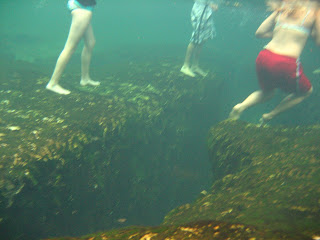 After an easy day Saturday on Alexander Creek, I decided to paddle Rock Springs Run, Sunday, May 18, 2008. I considered Blue Spring, which would have meant 4 1st magnitude springs in 4 days, but decided I did not want to deal with the crowds and boats on the St Johns. I may do Blue Springs Thursday afternoon. My Plan "B" if there is more than a light chop in the Banana River No Motor Zone. Stay tuned.
After an easy day Saturday on Alexander Creek, I decided to paddle Rock Springs Run, Sunday, May 18, 2008. I considered Blue Spring, which would have meant 4 1st magnitude springs in 4 days, but decided I did not want to deal with the crowds and boats on the St Johns. I may do Blue Springs Thursday afternoon. My Plan "B" if there is more than a light chop in the Banana River No Motor Zone. Stay tuned.Wekiwa Springs had just a few visitors when I arrived. I was in the water just before 9 am. An alligator was on the far side of the lagoon. As I paddled closer to the alligator, I saw the large snapping turtle I often see in this area. Into the Wekiva River, I saw a blue heron and thought, there usually is a green heron around here... and there it was. A red shouldered hawk eyed prey from a low perch, seeing me, it flew away before I aimed the camera. Reaching Rock Springs Run, I began the upstream journey. This turtle wasn't going anywhere.

Wading birds, herons. egrets, ibis and limpkins fed in the open, marshy sections of the Run. On my right, a flash of white- a deer tail flashing as it ran away from shore. (not the first picture, that was taken on the return). A bit later, the sound of something large on my left. Round the bend, a large gator slunk into the water. An image appeared in my brain; the Grinch slithering around the Christmas tree. The Run is very narrow, and clear here. I thought I may see the gator underwater. It either hid under some roots on the opposite bank, or with a few flicks of its tail, hurried away from danger-me.
I had the Run to myself. Passing the Otter Campsite, I saw camping gear packed and ready to go, but saw no campers. There was a large group at Indian Mound, 4 canoes tied to shore. Passing the last campsite, Big Buck, no boats, but I said good morning to a gentleman, a hiker from the look of his footwear. The primitive campsites are about the halfway point of the Run.
I paddled another 30 minutes before I began to encounter downstream paddlers.
A canoeing couple asked me "How far to the white, sandy beach?" I had to tell them there was no "white sandy beach", they had been misinformed. Another couple asked a similar question. I told them, that if the campsites were not occupied, they could stop there. None of the campsites have a beach. There is a small sandbar, near the confluence with the Wekiva, but by that time the trip is almost over. Other than that, to take a break, you just need to find a flat spot on the shore- and always test the bottom with your paddle before stepping out. What appears to be solid ground often is not. A kayaking pair likely knew that. The female half, said "You're doing what we usually do, paddle upstream". Then she said they recognized me from last year. I responded I was glad I made an impression. As the current carried us apart she called back, "You said we were enthusiastic !" "and you still are", I replied.
I left the State Park waters, passing the canal leading to Kings Landing and entered the beautiful upper section of Rock Springs Run.

Saw this deer shortly before turning around, having been out four hours, and having a fair volume of water in the yak from the leak, and an empty water bottle, it was time to turn around.

The view from the flat spot where I drained the yak, filled the water bottle, and had a sandwich.

These swamp lilies were at my usual lunch spot.

I saw a few people in the area near King's Landing, but no one from well outside the State Park waters to below the campsites.
Spotted a swimming gator, and a few youngsters like this fella.

Here are some of the bird of the marshy section.
Great blue heron, blue heron, ibis, limpkin.


A great egret flying past the hammock.

I had a passenger for much of the downstream float.
This is the scene at the canoe beach. I heard one of the workers say "We sent out 60 (something) white canoes, and ?? green ones"- Wow, and kayaks weren't mentioned. Most renters stay close to the Park. By paddling upstream, I avoided the horde.

The spring itself was still busy by the time I dragged the yak up the hill and tied it to the roof.


Minnows were the only non-human critters I could find.

I took a 20- 30 minute post swim walk. With the sun setting late, no deer where I often see them at dusk. Back at the now empty Spring, I was tempted to go in again. But, it was the end of a long day and long, fun weekend, so I made my way home.




A lovely tale, Mr. Yak. Thanks for it.
ReplyDeleteMy pleasure, Mr. Snake.
ReplyDelete